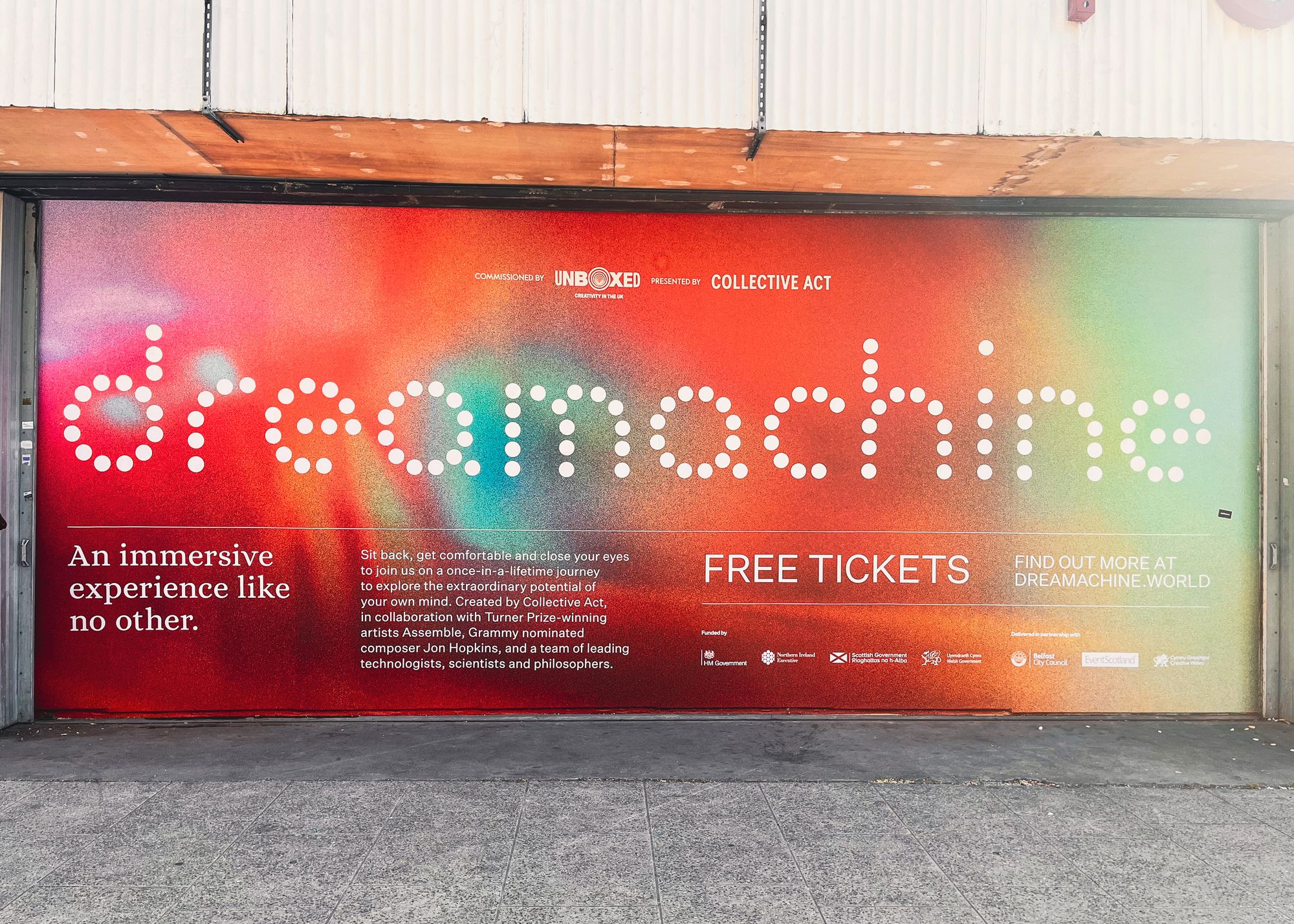Welcome to Afterglow, a newsletter that will change your mind. My name is Charles Bliss and I'm a psychedelic journalist from Norwich, UK.
This week we are exploring the limitless potential of the universe behind our eyelids. Take off your shoes, grab a blanket and close your eyes. We're going into the Dreamachine.

Exploding clouds, spiderwebs of golden electricity, shattering light, rainbow vortexes, fractals, haloes — I saw it all in the Dreamachine. But in what sense did I see it, if my eyes were closed?
A free immersive experience from UNBOXED, Dreamachine uses light and sound to conjure a technicolour dreamworld in the space behind your eyes. The exhibition is inspired by the inventions of Brion Gysin and created by leading minds in technology, architecture, music, neuroscience and philosophy.

On a balmy Friday afternoon, I alight from the newly opened Elizabeth Line and exit the station towards Woolwich Public Market. I am welcomed with the peal of a QR code scanner and asked to stow away my backpack, shoes and smartphone in a small locker before stepping into a holding space with thirty other people, who slink down onto the red carpet or balance on accordion benches made of brown paper. We sit before a large structure of painted blue wood, the cerulean whorls themselves worthy of a hallucinogen. Inside, a futuristic oval houses a continuous loop of seating with an orb at the centre. The space reminds me of a planetarium.
Dreamachine uses strobe lighting and wraparound sound, composed by Jon Hopkins, to elicit hallucinations. Each person's experience is unique to them and unrepeatable. Blankets and eye masks are provided — the masks intended to terminate the visions if they become too intense.
We are given our flight instructions: position yourself between two speakers built into the headrest; decibel levels will reach no higher than a night club; you can leave at anytime, with no judgment; seek assistance by waving your hands. Staff also provide reassurance that we go through the experience together as a group, even if we arrived alone, as I have. It begins with a breathing exercise.
As the music washes into my awareness like an inbound tide and the first flickering commences, my heart rate increases and body temperature spikes. But the blush of anxiety disintegrates as my mind is eaten by a kaleidoscope.
Geometric shapes warp and dissolve, flash and transform, scintillate and collide, pulse and recede. The most dramatic was an undulating black and white pattern reminiscent of the chevron floor in the Black Lodge from David Lynch's Twin Peaks, which erupted with fountains of rainbows. I had another vision of string theory — the idea from theoretical physics that reality is composed of infinitesimal vibrating strings, smaller than atoms, electrons or quarks. The most helpful frames of reference to approximate my experience would be Walt Disney's Fantasia and Jupiter and Beyond the Infinite from Stanley Kubrick's 2001: A Space Odyssey.
On the other side, we enter the integration space. I childishly scratch my bastardised interpretation of one of my visions onto black paper with coloured chalk and record reflections into a tablet, which generates a digital representation of my hallucinations. It falls way short of the mark. I melt into a beanbag chair for a time, before pushing through the door and emerging once again into the heady afternoon sunlight.

Dreamachine is a visceral aesthetic experience. It does what the most spectacular art and mythology can do. Namely, it can invoke the mysterium tremendum — an overwhelming sense of awe we feel contemplating the sublime. It ruptures our body of experience and leaves exit wounds where potential new avenues of thought might escape. What is the nature of consciousness? How can we see things that aren't in physical space? Why is my experience unique to me and not replicable by someone else despite the same stimulus?
These are the types of phenomenological issues that psychedelic-assisted therapy provokes. Yet Dreamachine demonstrates that psychedelics are not the only way to enter these states. Archeological and anthropological records show that humans have been altering states of consciousness for thousands of years. Other methods involve fasting, meditation, drumming, dancing and chanting, for example. But the purpose is the same: exploring the mind.
Dreamachine is in London until 24 July, then tours Cardiff, Belfast and Edinburgh.
Charles Bliss
🤯 Mind at Large
A breakdown of mind-blowing ideas I encountered this week:
📖 Book – The Psychedelic Explorer's Guide by James Fadiman. This is a useful manual for those interested in embarking on a psychedelic experience either as a "voyager" (the person taking a dose) or a "guide" (the person trip-sitting whom, incidentally, often experiences a contact high). Fadiman's book is an excellent resource with information on how to prepare for and navigate the psychedelic experience, and also includes accounts from influential figures in psychedelic research including Albert Hofmann, Aldous Huxley and Timothy Leary, among others.
🎬 YouTube – Best of Classic NeuroSoup. This playlist of educational and harm reduction drug videos from Krystle Cole describes the effects of LSD, MDMA, psilocybin and DMT, as well as Hallucinogen Persisting Perception Disorder (HPPD).
"As no two people see the world the same way, all trips from here to there are imaginary; all truth is a tale I am telling myself."
Brion Gysin
🫠 Enjoying this newsletter?
Forward to a friend and let them know where they can subscribe.
